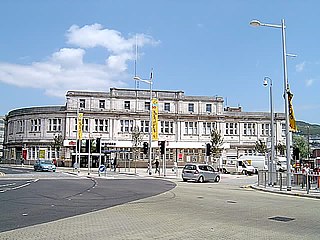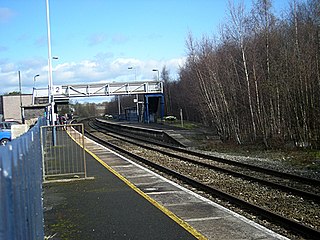Related Research Articles
The Rhymney Railway was a railway company in South Wales, founded to transport minerals and materials to and from collieries and ironworks in the Rhymney Valley of South Wales, and to docks in Cardiff. It opened a main line in 1858, and a limited passenger service was operated in addition.

The Welsh Marches line, known historically as the North and West Route, is the railway line running from Newport in south-east Wales to Shrewsbury in the West Midlands region of England by way of Abergavenny, Hereford and Craven Arms and thence to Crewe via Whitchurch. The line thus links the south of Wales to north-west England via the Welsh Marches region, bypassing Birmingham. Through services from south-west Wales, Swansea and Cardiff to Manchester and from Cardiff to Wrexham, Chester, the north coast of Wales and Anglesey constitute the bulk of passenger operations on the route.

Peterston-super-Ely is a village and community situated on the River Ely in the county borough of the Vale of Glamorgan, Wales. The community population at the 2011 census was 874. The community includes the hamlet of Gwern-y-Steeple.

The Vale of Glamorgan Line is a commuter railway line in Wales, running through the Vale of Glamorgan from Barry to Bridgend, via Rhoose and Llantwit Major.

Llantwit Major railway station is a railway station serving the small town of Llantwit Major, South Wales. It is located on the Vale of Glamorgan Line, 18+1⁄4 miles (29.4 km) west of Cardiff Central towards Bridgend via Barry and Rhoose. The present station opened on 12 June 2005, when passenger services were restored on the section of line between Barry and Bridgend.

Bridgend railway station is a main line station serving the town of Bridgend, south Wales. It is located approximately halfway between Cardiff Central and Swansea stations, at the point where the Maesteg Line diverges from the South Wales Main Line; it is also the western terminus of the Vale of Glamorgan Line from Cardiff. It is 165 miles (266 km) measured from London Paddington.

Swansea railway station serves the city of Swansea, Wales. It is 186 miles 7 chains (299 km) measured from London Paddington on the National Rail network.

The West Wales lines are a group of railway lines from Swansea through Carmarthenshire to Pembrokeshire, West Wales. The main part runs from Swansea to Carmarthen and Whitland, where it becomes three branches to Fishguard, Milford Haven and Pembroke Dock.

Briton Ferry railway station is a minor station in the village of Briton Ferry, south Wales. It is 181.5 miles (292 km) from London Paddington. The station is located at street level at Shelone Road in Briton Ferry. It is a stop on the South Wales Main Line, served by Transport for Wales Swanline regional trains between Swansea and Cardiff.

Pyle railway station is a minor station in Pyle in Bridgend county borough, south Wales. The station is located at street level at Beach Road in Pyle, 171.5 miles (276 km) from London Paddington.

Gowerton railway station serves the village of Gowerton, Wales. It is located at street level at the end of Station Road in Gowerton 5+1⁄2 miles (8.9 km) west of Swansea. The station is unmanned but has a ticket machine, shelters on each platform and live train running information displays.

The Barry Railway Company was a railway and docks company in South Wales, first incorporated as the Barry Dock and Railway Company in 1884. It arose out of frustration among Rhondda coal owners at congestion and high charges at Cardiff Docks as well the monopoly held by the Taff Vale Railway in transporting coal from the Rhondda. In addition, the Taff Vale did not have the required capacity for the mineral traffic using the route, leading to lengthy delays in getting to Cardiff.

Whitchurch (Shropshire) railway station serves the town of Whitchurch in Shropshire, England. The station is 18¾ miles (30 km) north of Shrewsbury on the Welsh Marches Line. The station is maintained and served by Transport for Wales.
The Llanelly Railway and Dock Company was an early Welsh railway system. It opened its first short line and a wet dock at Llanelly in 1834, and soon went on to build a longer line from Llanelly to serve pits in the Amman Valley, and then on to Llandilo, reached in 1857. The Llanelly company leased and worked the Vale of Towy Railway on to Llandovery, from 1858.
The Vale of Neath Railway (VoNR) was a broad gauge railway company, that built a line from Merthyr Tydfil and Aberdare to Neath, in Wales, chiefly to transport the products of the Merthyr iron industries to ports on Swansea Bay.
The Vale of Glamorgan Railway Company was built to provide access to Barry Docks from collieries in the Llynvi, Garw and Ogmore areas. Proposed by the coalowners but underwritten by the wealthy Barry Railway Company, it opened in 1897 from near Bridgend to Barry, in Wales.
The Rhondda and Swansea Bay Railway was a Welsh railway company formed to connect the upper end of the Rhondda Fawr with Swansea, with the chief objective of transporting coal and other minerals to Swansea docks. It was incorporated in 1882, but at first the connection to Swansea from Briton Ferry was refused.
Hirwaun was a railway station serving the village of Hirwaun in Rhondda Cynon Taf, Wales.

St Fagans railway station served the village of St Fagans in South Wales. The station was on what is now the South Wales Main Line.
Ely Main Line railway station served the suburb of Ely, Cardiff until the 1960s.